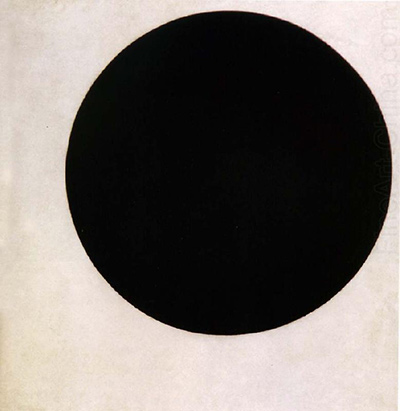Black Circle is a painting Malevich created in 1915. It is known as an oil-on-canvas art piece that is based in pure abstraction by using basic forms. The work represents a large perfect circle that is black in colour, floating on a white background.
The black circle is located in the upper right hand corner of the canvas. When a person first sees the painting, it appears to be a simple black circle on a white background, but upon closer inspection, a person is able to see that the circle seems to draw you in, causing several significant spiritual feelings to surface.
The piece is one of the best known paintings of the style, along with his other works including Black Square. It illustrates pure geometric shapes in one of the primary colours. The painting was first displayed in an exhibition held in St. Petersburg in December 1915. It was one of the 35 pieces shown, all of which were abstract art pieces.
The exhibition was held at the same time that Malevich released his manifesto entitled “From Cubism to Suprematism”, launching what was known as the Suprematism movement. He described the Black Circle, Black Cross and Black Square paintings as new icons in the spiritual world for the aesthetics of the modern are movement.
Malevich thought that the style of his work reflected the simplicity and clarity of traditional piety as seen in Russia as the time. His ideas about the style were later in-line with Bolsheviks and his art. The pieces were well received by critics but they did not get the same reception with the general public and as a result, he lost public approval. Stalin would later persecute Malevich due to the mistrust that he had with modern art works.
In Malevich’s manifesto, he explained how he was trying to break artists from the objective world to the pure forms that he believed to be superior. He was attempting to give his paintings the same kind of feeling to the general viewer as other religious works did and ultimately wanted them to be understood by everyone.
Michael Brenson talked about Malevich’s pieces (1990) saying that the one thing that remained constant throughout the paintings was the white background that was always selfless yet distinct. He continued with remarks such as the white background was neither closed or open but somehow both simultaneously. Nothing felt trapped by the background. The work that Malevich did had a strong influence on 20th-century art as well as photography in the 1920’s and 30s. It also influenced the op art movement (1960).
Kazimir Malevich was a Russian painter that is seen as the pioneer of the geometric abstract art style and one of the first painters to work on the genre. He started the avant-garde Suprematist movement with his artistic creations. He believed that the ultimate goal of art was to capture a feeling of spirituality as an emotion. Kazimir Malevich was born on 23 February 1878 and died on 15 May 1935.




